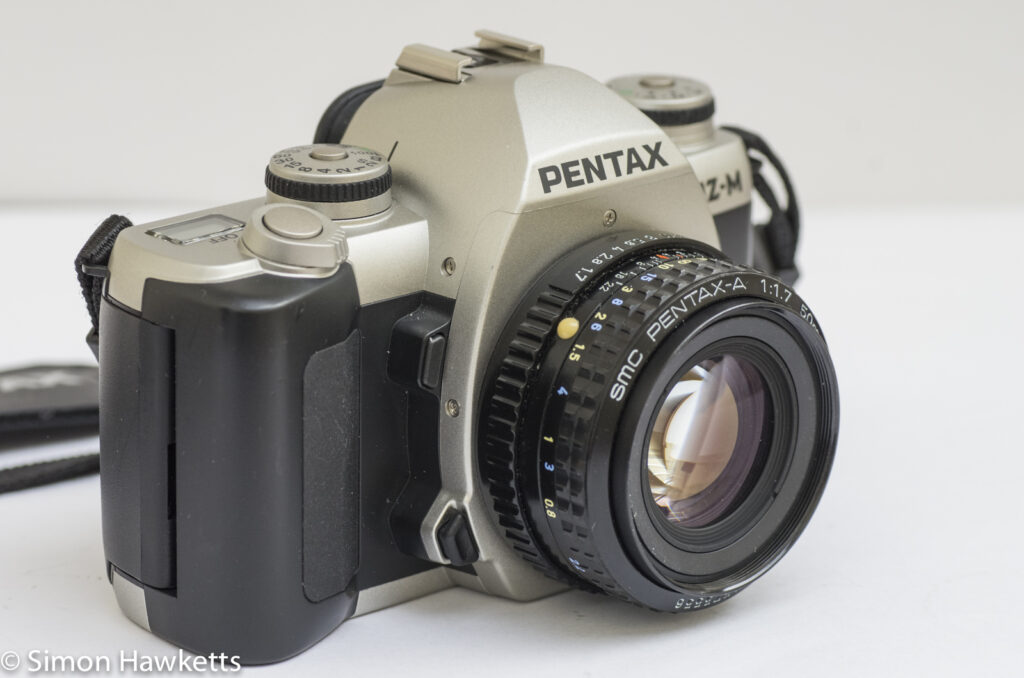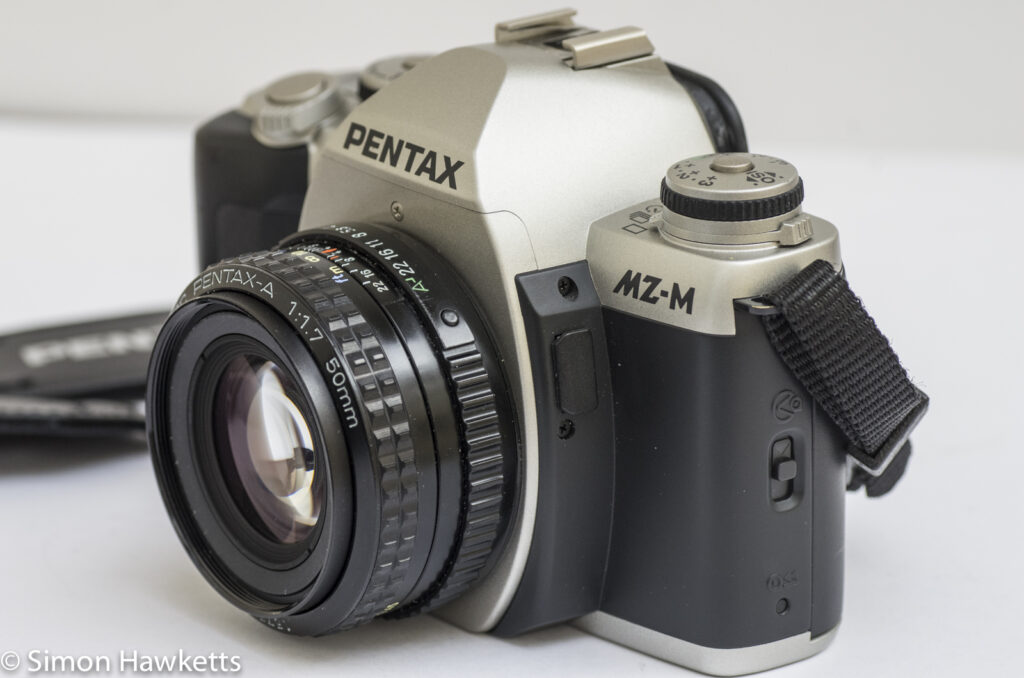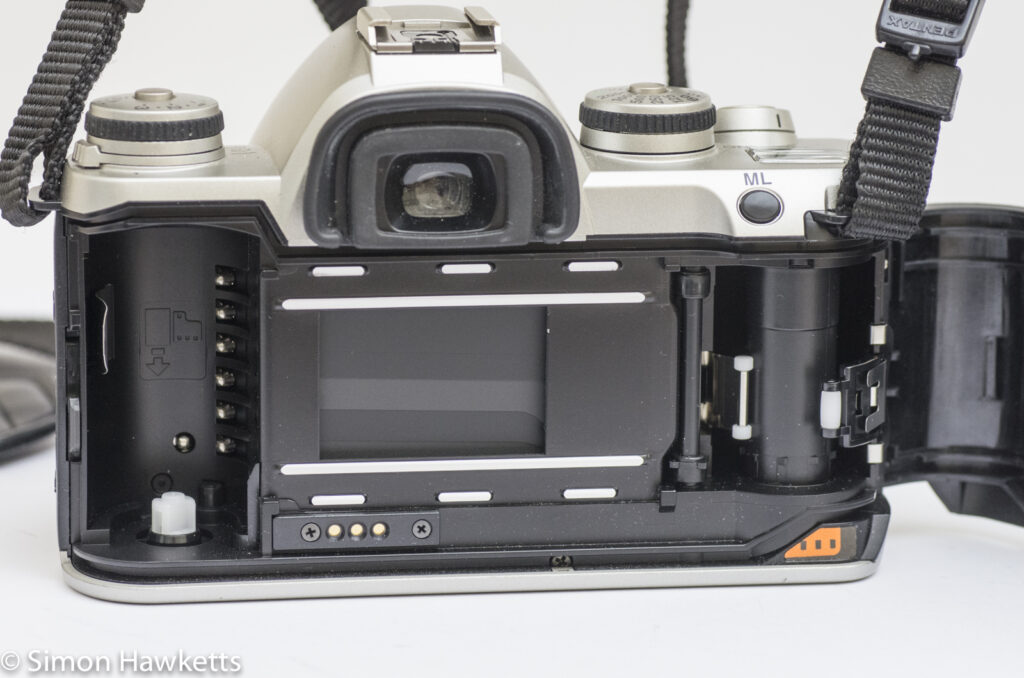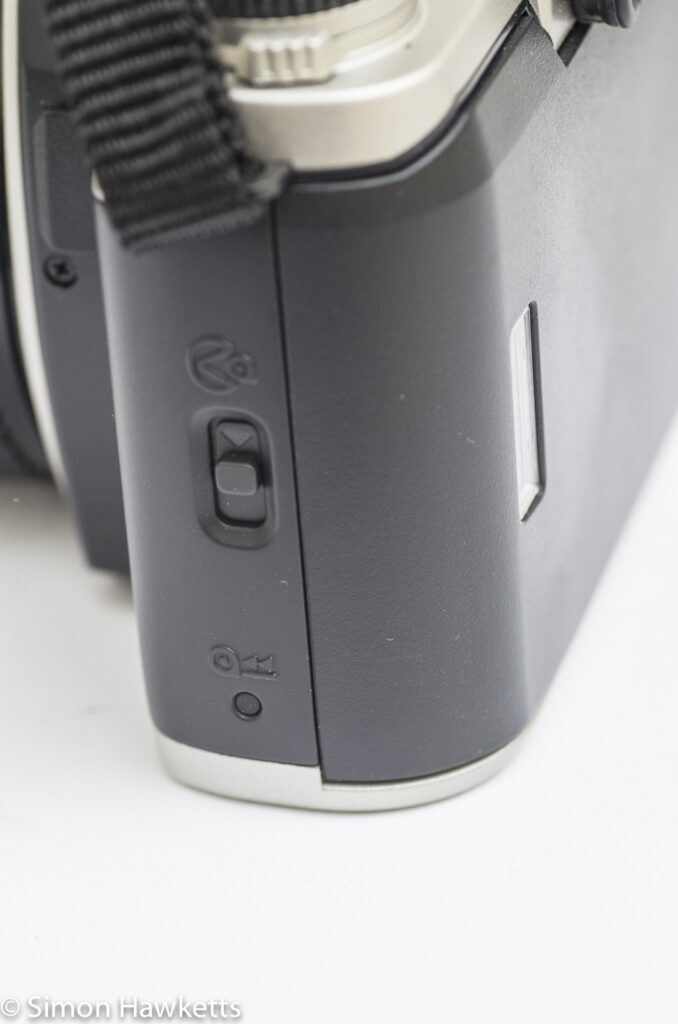Pentax MZ-M 35 mm SLR
I’m having a bit of a run on the Pentax MZ series at the moment, and my recent purchase of the Pentax MZ-M helps in my aim to own every model produced. As it stands I have nearly all the entry/mid level examples except the MZ-10, but I still need to get some of the top end models, MZ-6, MZ-3 and MZ-S. I will probably be able to get the MZ-6 and the MZ-3 but the MZ-S is still selling for up to £350, so I suspect it will be a while before I get that model.
Pentax MZ-M Images













My Pentax MZ-M Camera
I paid £10 for my MZ-M which was for the body only without a lens, but with a Pentax strap fitted. Like all the MZ series cameras I own, it is in very good condition cosmetically, with hardly a mark on it other than a couple of light scratches on the bottom casing. Although these cameras are light weight and plastic in construction, they certainly seem to have stood up well to the years of use they have been put to – either that or these cameras just never got used!
Pentax MZ-M description
This camera is unique in the series in that it was the only manual focus model, and so it had better assistance for getting the focus right than the autofocus versions. These consist of a split image rangefinder in the centre of the viewfinder and a micro-prism surrounding it. These are similar sort of aids which were fitted to cameras before autofocus became the norm and were pretty useful, although the split image is horizontal in this camera and I always found the ones at 45deg more useful.
The other big difference from the rest of the MZ series is that there is no built-in flash, only a hot shoe allowing a flash to be fitted to the prism.
I think the MZ-M is probably the lightest camera in the series, which I suppose is to be expected since all the autofocus mechanism has been removed from the body. That does actually make it very easy to carry about and use with a small prime lens, it’s easy to slip into the glove compartment in the car, so you always have it with you.
Since I only bought the body, I paired it with the SMC-A 50 mm f/1.7 which was originally fitted to my Pentax P-30 thinking this would make a great lens to use on the MZ-M, but I found there are some limitations. Although the camera will control the aperture in Program mode or Shutter priority, in Aperture priority and manual mode the camera can’t display the aperture that the lens is set to in the viewfinder. This is because the SMC-A series lenses don’t have the pin which communicates that information to the camera body. This is rather a shame, because it’s a great combination and leads to a nice bright viewfinder, but I tend to shoot in aperture priority, so it’s more awkward if I need to be continuously looking at the lens to see what the aperture is.
Exposure modes

The controls on the MZ-M are modelled on the cameras at the top of the MZ range like the MZ-5 and MZ-3 and therefore doesn’t offer ‘scene’ modes. Instead, there are a range of exposure modes, all controlled in a simple and effective way by the shutter speed dial on the camera and aperture ring on the lens.
If the shutter speed and the aperture are set by the photographer (i.e. not in ‘A’ mode) the camera is in manual exposure mode and will give an indication in the viewfinder to show if the exposure will be correct with the settings chosen. This is in the form of a bar graph on the right-hand side of the viewfinder display which shows +/- 3 stops and can indicate more than 3 stops by blinking the + or – sign. It’s a simple matter to adjust either shutter or aperture to achieve the correct setting. The shutter speed is displayed in the viewfinder along with the aperture if an F series lens is fitted.
If either the lens or the shutter speed dial are moved to the ‘A’ position, the camera automatically sets that parameter to take the picture. So setting the shutter speed to ‘A’ places the camera in aperture priority mode and setting the lens to ‘A’ sets the camera in shutter priority mode. If both dials are in the ‘A’ position, the camera is in program or fully automatic mode – simple. When in the auto exposure modes, the 3 stop indicator is used to apply exposure compensation, which is dialled in using a separate control on the top left of the camera.
Metering modes
The MZ-M doesn’t have the metering mode selection switch of the MZ-5 and 3 models, so you can’t change the metering pattern the camera uses. It will take a 2 segment averaged reading when an FA, F or A series lens is fitted and a centre weighted reading if M series K-Mount lenses or M42 lenses with an adapter are used. A meter lock button is provided to lock the metered settings, which can be handy when the scene has areas with large lighting differences. To use it you point the camera at the area you want to expose for, press the ML button and then recompose to take the picture. The camera locks the exposure for 10 sec, or until the picture is taken.
Drive modes
There are three drive modes provided:
- Normal single shot mode where the camera will advance the film ready for the next shot
- Continuous mode, where the camera will advance the film and take pictures while the shutter release is held
- Self-timer mode, which will add a delay to the shutter of 10 seconds
These modes are all selected with a switch around the bottom of the exposure compensation dial.
Viewfinder
Something which worried me before I received this camera was the fact that I had read a few posts from people complaining about the quality of the viewfinder. People complained about the size and brightness, mostly because it is fitted with a Penta Mirror rather than a pentaprism. I have to say, I didn’t find anything to complain about. I found the viewfinder quite bright and the split rangefinder to be a very useful focusing aid. The only thing I found to be a bit dull was the LED annotation on the right-hand side of the viewfinder.
Other Features
Other notable features of this camera are the ability to override the DX coded ISO, mid-roll rewind, depth of field preview and a proper KA2 lens mount which allows it to work with all K mount lenses. Things which could have been improved would have been a metal lens mount rather than a plastic mount, but as manual focus cameras go this is a pretty nice example.
Pentax MZ-M Specifications
- Pentax MZ-M 35mm manual focus SLR
- Manual focus with split rangefinder focus aid
- Depth of field preview
- Focal plane shutter 1/2000th to 30sec (1/2000 to 2sec selectable)
- Motor driven film advance. Up to 2fps in continuous mode.
- Aperture priority, shutter priority, program mode and manual mode
- Metering Lock button
- ISO 6 – 6400 with DX coding + manual override
- Average metering with 2 segments
- Pentax KA2 mount with full lens compatibility
- Electronic cable release socket
- +/- 3 stops exposure compensation
- Top panel LCD
- Powered by two CR2 lithium cells
- Simple and effective control layout
- Ser No : 3950768
- Manual available on-line here
Sample Pictures
I’ve takes some pictures with this camera and developed in caffenol – see this post.
Discover more from Everything Vintage
Subscribe to get the latest posts sent to your email.





